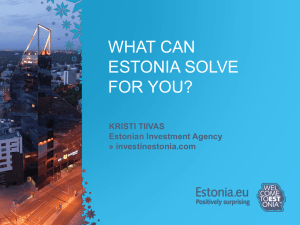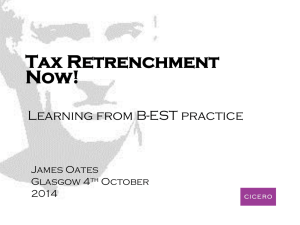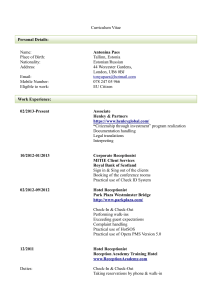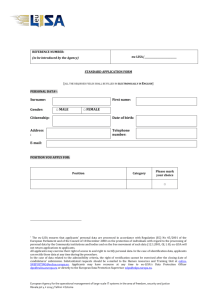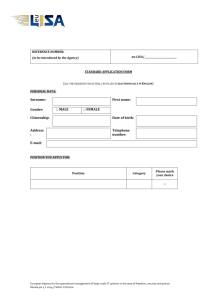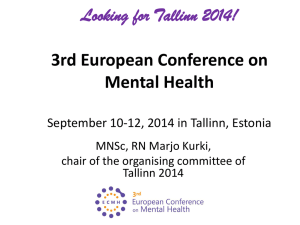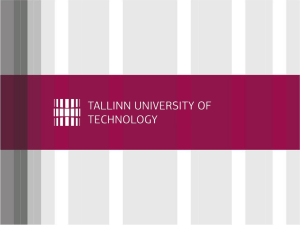EXECUTIVE S Report to Enterprise E Estonia's Mee October
advertisement
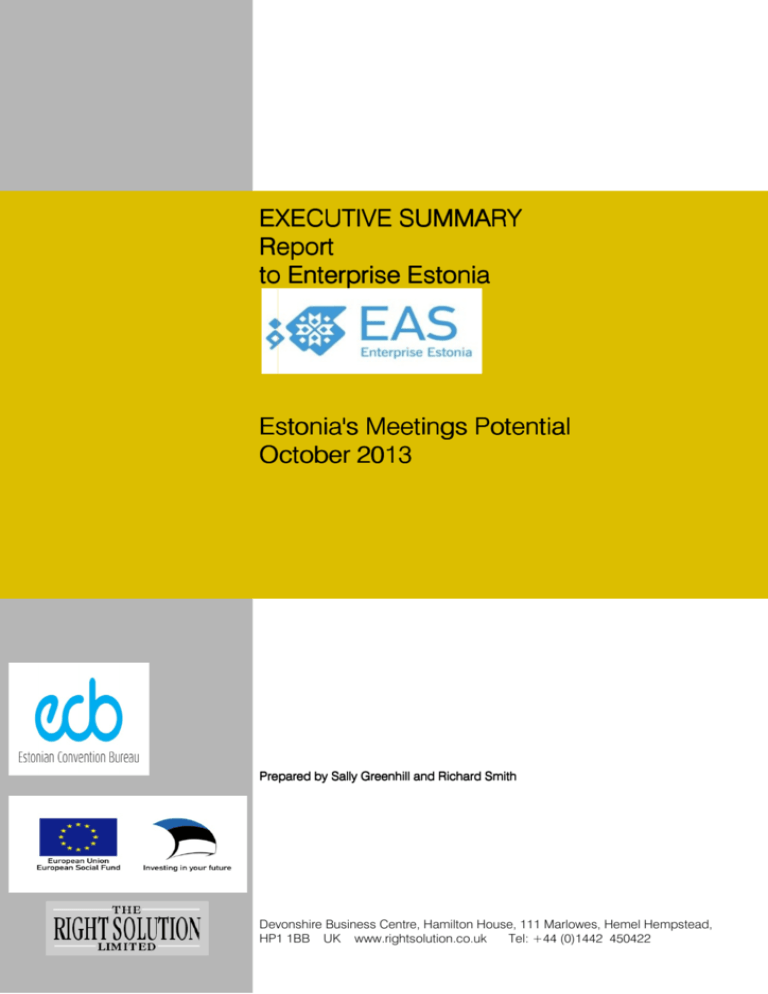
EXECUTIVE SUMMARY Report to Enterprise Estonia Estonia's Meetings Potential October 2013 Prepared by Sally Greenhill and Richard Smith Devonshire Business Centre, Hamilton House, 111 Marlowes, Hemel Hempstead, HP1 1BB UK www.rightsolution.co.uk Tel: +44 (0)1442 450422 Executive Summary of Estonia's Meetings Potential Report Executive Summary The Right Solution, in partnership with TEAM Tourism Consulting, was appointed to undertake a study into the potential for Estonia to increase demand for international congresses and conventions, and to examine to what extent a new congress centre would help increase demand. The study focused on Tallinn since this is where Estonia’s main potential within international conference markets lies. The infrastructure for Tallinn, access, hotels and greater visitor offer means it is more easily able to succeed in the competitive international conference marketplace. However the benefits will be realised to Estonia overall and this is discussed later in the report. Key recommendations In order for Estonia to increase the number of international association conferences it attracts per year there is a need for: 1. An International Convention Centre providing purpose designed facilities suited to the needs of international associations 2. Increased air routes worldwide and frequency of options 3. Increased hotel stock. If the above recommendations were implemented the rewards for Estonia could be great with additional spend to the value of €15 million and creation of 404 jobs. Conference delegates, particularly international ones are high spending visitors. Conference tourism brings significant other benefits to a destination. For example it typically compliments the seasonality of leisure tourism, contributes to overall place marketing and inward investment, enhances the quality of life for residents, and contributes to knowledge capital within a city and country. The country's universities and hospitals have the opportunity to promote their leading academics and specialists through conferences, raising the international profile of the country overall. Estonia’s Estonia’s potential as a conference destination Estonia's current offer has a number of strengths as a conference destination. These include: • Its strong leisure offer. From a conference perspective this brings marketing advantages including an attractive environment for conference delegates, strong potential for partner programmes and leisure extensions. The significant leisure trade also supports facilities and an infrastructure that are of importance to conference markets (restaurants, bars, retail and hotels), it is used to managing visitors, service standards are good and the city centre is compact. • Venues. There are good large venues available in Tallinn including the Nokia Concert Hall, Estonia Concert Hall and Saku Suurhall, together with good facilities in a number of hotels. Meeting spaces, particularly in the hotels are generally flexible, modern and well designed. However these lack the formula of facilities required to host many association conferences and business is being lost as a result. It has been estimated that conferences to the value of €15 million have been lost since 2009 due to lack of appropriate facilities. ©The Right Solution Limited 21st October 2013 2 Executive Summary of Estonia's Meetings Potential Report • Hotels. Hotels. With over 4500 business class rooms in Tallinn (approximately half of which are in the €86 or above price category), there are good standards of hotel accommodation in Tallinn. Much of this stock has been developed or seen significant new investment in recent years. Facilities are modern, and prices competitive, particularly in comparison to hotels elsewhere in Northern and Western Europe. • Proactive convention convention bureaus bureaus and ambassador programmes. programmes Estonia and Tallinn both have well established and professional conference bureaus. A core element of their promotional activity is the ambassador programme which has high calibre members in a position to invite bids for their association's conferences with the right facilities. • Economic and cultural strengths. Estonia and Tallinn have a number of other economic and cultural strengths that are assets for conference development. These include strengths in a number of economic and academic sectors, languages, excellent free Wi-Fi available, a young, well educated population, and a national willingness to participate and co-operate internationally. Comparing Tallinn to regional competitors, it is performing well for a city of its size and relative to its population as it attracted the highest proportion of international meetings. In absolute terms it is in a strongly competitive position when compared to its non-Scandinavian (i.e. Baltic, Russian and Polish) competitors. In 2012, there was an estimated 164,000 conference (and partner) visits to Tallinn. This generated an estimated direct spend of €29.5m. The most recent estimate of spend for delegates in Estonia is €179 per day. However delegate spend can be as high as US$2551.60 per delegate (source: ICCA). Currently Tallinn lacks the required conference facilities, air routes and, to a lesser extent, hotels to compete in absolute terms with larger destinations. If conference tourism is to develop further, Estonia and Tallinn will need to address a number of challenges. These include: • A purpose built convention centre While existing venues in Tallinn are a strength they also represent a challenge. There is no international quality purpose built congress centre in Tallinn. The Nokia Concert Hall struggles to compete with modern purpose built centres worldwide as banqueting, breakout and exhibition space are not available for larger events. As a consequence a multi-venue approach needs to be adopted and this is not suitable for many organisers particularly in winter periods. The experience is not up to the standards found in convention centres in other cities worldwide. • Transport links. Tallinn has good regional transport links (air, rail, and ship) with Scandinavia and the other Baltic Countries. However, air linkages to other Western and Northern European countries, and to non-European destinations are more weakly developed and, importantly, perceived as poor by conference organisers. In addition, Estonia’s location in North East Europe is not considered central enough location for many associations so rapid air links become even more important. • Hotels. Tallinn lacks major international brands (with the exception of Swissôtel, Radisson and the Hilton due to open in 2016). Looking to the future, if Tallinn is to cater for more and larger conferences it will need sufficient accommodation (and a range) within the vicinity of a conference centre, and a ‘headquarters’ adjacent or linked to a centre. This would ideally provide a minimum of 150-200 bedrooms and preferably be of four star standard or higher. Using current hotel supply, at ©The Right Solution Limited 21st October 2013 3 Executive Summary of Estonia's Meetings Potential Report many times of year larger conferences will require additional bedspaces particularly in 4* or 5* brands. In terms of international market potential for Tallinn, the international association market offers the best potential for growth but, without a large, modern congress centre able to meet all market requirements the city is unable to compete internationally. This is preventing Tallinn from fulfilling its potential as a premier destination for conferences and events. The top 40 cities worldwide for international conferences all have major convention centres, and a high status iconic building is increasingly important to help market the destination. There is growth potential from the international corporate market for Estonia, albeit more limited than the international association market. This is primarily because it is a less discretionary market and is more reliant on the development of industry sectors and businesses. The identified sectors for future development of ICT, Health technology & Services and Efficient use of resources (as identified in the Smart Specialisation project) are typically sectors generating large numbers of meetings. They too will demand a state of the art convention centre. Tallinn also has potential to further develop its incentive market but its current offer needs further development. Similarly the potential for the stand alone exhibition market is reasonable (although lower than many countries due to the lower population number) but the current facility offer is poor and modern exhibition facilities are a key requirement to developing this market. Options Appraisal Estonia is losing international association business as it is not able to meet all their requirements. Tallinn offers the best opportunity for the country to increase conference business if it was able to provide all the facilities needed for regional and international association conferences, major corporate events and smaller stand alone exhibitions within one purpose built facility. Within this study a number of options have been explored for the development of conference and exhibition facilities. These include: • Remain as current – i.e. 'Do Nothing' Scenario • Develop existing facilities – e.g. the Saku Suurhall, Nokia Concert Hall, and Radisson Olympia Hotel • Development of a small conference centre with a 1500 m2 main hall • Development of a large conference centre with a 5000 m2 main hall • Development of a Conference and exhibition centre with 5000 m2 main hall plus additional 5000 m2 for exhibition space. Each scenario has advantages and also issues. The 'do nothing' scenario will lead to a decline in the number of international association meetings being attracted to Estonia as the majority of the conferences suited to the existing facilities will have already taken place and it has already become difficult to replace them with new conferences. The development of existing facilities is not seen as realistic options. For example the land is not available adjacent to Nokia Concert Hall to add the required facilities and Estonia Concert Hall is limited by its size, age and style. Reconfiguring Saku Suurhall would be costly. ©The Right Solution Limited 21st October 2013 4 Executive Summary of Estonia's Meetings Potential Report Taking into account the demand and supply information collated to date, the recommendation is to provide new facilities with the following elements: • Flexible plenary facility large numbers of at least 1,500 delegates • Range of breakout rooms varying in size from 20 to 1,000 • Catering space for 1,500 plus for a major banquet. • Exhibition space of up to 5,000 square metres, or more depending on the requirement to accommodate stand alone exhibitions • Ancillary and support facilities. • Supporting infrastructure. There are three new build options outlined, of which the development of a large convention centre with a 5000 m2 main hall (Option 2) is the recommended recommended approach in terms of cost and potential return . However if an additional new Fair Centre was to be developed this could dilute the market for the convention centre and the option to combine the two into one convention & exhibition centre with additional exhibition space would be preferable. This is shown as Option 3 and would be more expensive to develop. Three potential sites for a large conference centre have been identified in Tallinn. These are: • The site between the Noblessner land and the Sea Plane Harbour Museum • Reconfiguration and refurbishment of the Linnahall • Ülemiste City adjacent to the airport. The steering group for the study scored each site against a range of criteria such as demand potential, regeneration impacts, access and links, proximity to the city centre. While each site has differing strengths, the site between Noblessner land and Sea Plane harbour has the marginally highest score of the three. Options for operating a convention convention centre There are various structures available for the operation of a convention centre: • Outsourced for operation by a private company who are specialists in convention centre or venue operation • Operated by the state or local authority as a government department • Set up as a separate commercial entity which is wholly owned by the state or local government • Combination of local authority and specialist contractor such as catering company or facilities management organisation. The pros and cons for each of these options are summarised in this report. At this stage the financial projections that have been prepared assume the operation as a separate commercial entity. However management fees for a private operator have not been allowed. Financial projections Hypothetical diaries of events and a pricing policy have been used to prepare revenue estimates for each of the three conference centre options. The diaries results in a total number of events as follows: Type of event Association conferences ©The Right Solution Limited 21st October 2013 Option 1 Option 2 Option 3 16 21 21 5 Executive Summary of Estonia's Meetings Potential Report Type of event Option 1 Option 2 Option 3 Banquets 0 12 12 Corporate meetings 0 12 12 Exhibitions (stand alone) 0 6 10 Festival (entertainment) 0 July July From the revenue estimates, the net surplus year 4 (stable year) for each centre option has been estimated as follows: Total Revenue Year 4 Forecast Surplus Year 4 Option 1 € 4,138,533 € 964,050 Option 2 € 8,779,773 €2,344,988 Option 3 € 9,751,927 €2,657,729 Underpinning projections are a range of assumptions including additional funding for the convention bureaus to ensure proactive marketing could take place and subvention funding. The required subvention budget could be as much as €1,000,000 in order to deliver the target conferences that return the greatest economic benefits. In addition a management fee would be needed if a private independent operator was preferred. Economic impact estimates for hypothetical diaries The following table summarises the estimated potential gross economic impact in the destination by international conference delegates of the hypothetical events diaries for the three development options. Development option Option 1: Small centre Option 2: Large conference centre Option 3: Conference / exhibition centre No. of international visits No. of international nights 8,900 40,800 18,000 62,100 20,800 66,200 Gross direct spend (€m) Gross direct, indirect and induced spend (€m) 7.1 10.3 10.6 10.4 15.0 15.5 GVA (Direct) (€m) GVA (direct, indirect and induced) (€m) 2.5 3.6 3.7 3.6 5.2 5.4 Jobs (Direct) (€) Jobs (direct, indirect and induced) (€) 191 277 286 280 404 418 These figures relate only to international visitors and exclude spend by Estonians. They refer to spend in the destination on elements like accommodation, shopping, transport, entertainment. They exclude venue related spend and conference fees which could add up to a third if registration fees were apportioned to the local association. ©The Right Solution Limited 21st October 2013 6 Executive Summary of Estonia's Meetings Potential Report An important economic benefit is the generation of jobs through direct and indirect employment, shown in the table above as an estimated 404 jobs. These include many highly skilled jobs such as ICT specialists, audio visual technicians and management. In addition there are business extenders - those who stay on in the city or the region beyond the duration of the conference providing additional income and/or are accompanied by a partner, and returners who revisit the destination at a later date. International visitors are more likely to extend their stay or return than national delegates and also have typically higher spend levels. It is estimated that between 25% and 40% of attendees at conferences either extend or return to a region for a leisure visit at a later date, thereby increasing leisure tourism income (Source: ICCA). The development of the area around the congress centre will further enliven and animate Tallinn, attracting visitors and income for all local businesses. In turn this will encourage other business providers to this area. The catalyst for regeneration created by conference centres has been proven all over the world. The key conclusions and recommendations arising from this study are: • Tallinn is losing international association business as it is not able to meet all the requirements of the market • The development of a large conference centre with a 5000 m2 main hall is the recommended approach in terms of cost and potential impact. Initial estimates of costs of between €60 million and €75 million (excluding land costs) could return €15 million gross spend per annum and sustain 404 jobs. • Developers have already expressed interest in some of the sites outlined here so all options should remain under consideration and be progressed for this development. • The funding sources and financial viability going forward will steer decisions on the preferred option. • The development of a new conference centre needs to be supported by new air routes and hotels (both of which will be stimulated by the centre itself), increased convention bureau resources and destination marketing activity. ©The Right Solution Limited 21st October 2013 7

